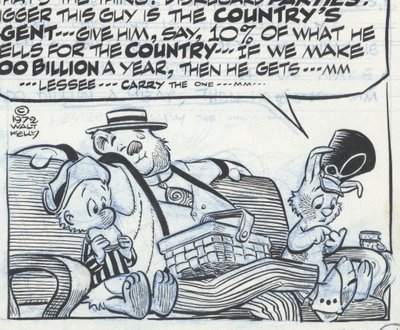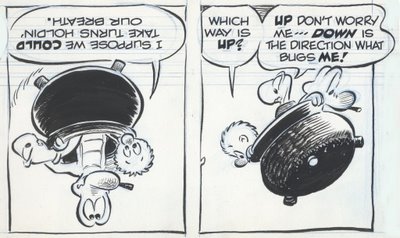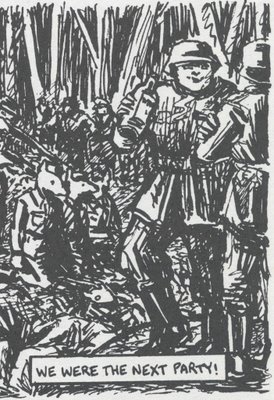
Why would any artist choose to work in the medium of the comic strip? The pictures are squeezed into tiny boxes where they compete for space with word balloons. The quality of reproduction is usually awful. And for writers, the medium has even less to offer. There is never enough space for words, and the flow of the narrative is chopped into short installments.
For many, these inherent drawbacks prevent comics from ever being a platform for truly excellent art.
But for at least one eccentric group, comics seem to be the best possible medium. Some artists with a strong personality and a talent for both words and images have found that comics allow them the freedom to combine all their strengths and realize their full artistic potential. These include George Herriman (Krazy Kat), Chester Gould (Dick Tracy) and Harold Gray (Little Orphan Annie). These creators could not have achieved the same heights by drawing and writing as two separate disciplines.
Among the greatest to use the special potential of the medium was Walt Kelly in his comic strip, Pogo.

Kelly starts out as an excellent artist. Note in the picture above how effortlessly he employs his knowledge of anatomy and his expressive line to serve the action in this panel: the raised shoulder, lowered head, splayed fingers and recoiling stance of the alligator are all conveyed with the kind of brush work that has not been seen in comic strips for many decades.
Similarly, in the following picture Kelly quietly understands that feet curve in toward each other:

But Kelly was also an excellent writer. Here he combines those drawing skills with his typically clever words:



Kelly could treat words like pictures and pictures like words.

The medium allowed him the freedom to play games and create effects that could never be found in an exclusively literary or visual art form.

Kelly's accomplishment was not just the sum of his drawing and writing. He invested his own distinctive personality and language to create a work that was uniquely his own.

I doubt he could have achieved such greatness in any other medium.
The medium does not suit everyone. Plenty of comic strip artists such as Frank Frazetta or Noel Sickles could not reach their full potential until they were set free from the straightjacket of the comics medium. And there are good writers such as John Updike who gave up drawing comics because they seemed to do better focusing on words alone.
It is easy to get the mixture wrong. Today we seem to have a lot of clever writers such as Art Spiegelman or Chris Ware who cannot draw well, and as a result the quality of the combined work suffers.

Those who were destined to be either an artist or a writer can do good work in comics, but they can never seem to take full advantage of the medium. But for the odd little band of eccentrics such as Kelly, Herriman, Gould and Gray there is no higher art form.

Great! I LOOOOOOVE comics, so for me it's no surprise at all to see them in a "Art" site! Makes sense to me. Oh, just one thing: I KNOW that your post its not a "Summum" of ALL the great comic strip artists, but i miss here E. C. Segar (very good, complex characters, and AMAZING talent for writing long histories) and Winsor McCay (Marvelous design, splendid use of the space combined with the narrative). Thanks!
ReplyDeleteThanks, Fabricari. I am often astonished by the difference in quality between the originals and the printed reproductions in newspapers. So many artists took the time and care to draw with a delicate hand, realizing their audience would never really see the difference. That's one reason I like to show the originals to the world.
ReplyDeleteI am reminded of Robert Fawcett's explanation for why an illustrator should always do his or her best even if the audience won't see or appreciate the difference: "The argument that 'it won't be appreciated anyway' may be true, but in the end this attitude does infinitely more harm to the artist than to his client.'"
Anendorf, I agree with you 100%. McCay and Segar are part of the pantheon of great comic artists. I love their work and the work of many others. I draw no bright line between comic artists and other kinds of artists.
ReplyDeleteI think I need to get a Pogo collection. It's been a long time since anyone recommended that to me.
ReplyDeleteI was always quite impressed with Watterson's brush work in Calvin and Hobbes.
And just a personal bias, but I hate to see a list of comic artist/writers that doesn't include Will Eisner or Frank Miller.
Great post, not enough people know or appreciate Walt Kelly.
ReplyDeleteHe was an adept animator as well.
Did he do his own lettering on these samples, or was it Henry Shikuma?
In any case, one of the greatest experiences of my collegiate life was to be able to sit alone at a table in the basement of a museum and see an original Pogo and Krazy Kat side by side. Something clicked in my brain and hopefully has influenced my own cartooning for the better.
David, I truly appreciate your knowledge, love and effort put into creating this blog. It is one of the very few sites that I regularily visit.
ReplyDeleteWe both share the lowe toward great art and great artists and I am glad I am not the only one which do not hold in high regard artists and pseudoartists (illustrators, painters, comic artists...) which do not deserve attention - let alone fame - they enjoy these days.
Thank you for these large scans. Upon seeing the original art one is able to see even more clearly Kelly's influence on generations of cartoonists. Frank Cho is the last in a long line.
Thanks, great article, great images. I have not know Mr. Kelly's work.
ReplyDeleteI agree with most of your conclusions, except for one: Chris Ware can draw comics, and can tell good stories. And his comics are complete. But this is my opinion, and I could be wrong. :-/
As others have said, comics are a unique art form, massively different from 'pure' drawing and 'pure' writing.
ReplyDeleteIn a recent post you talked about visual thinking. I think comics can be thought of as writing using pictures. In that sense, Spiegelman and Ware are two of the best comic creators who ever existed, on par with Kelly, Herriman and McCay (even if their drawings are not).
Wonderful! The man was truly an authentic clinical genius, everybody knows that. But, to top it all, your presentation is great. Very well written, right on point, and very instructive. (even for me, a Pogo scholar for the last 40 years...) Wonderful!
ReplyDeleteNow, some of the drawings are easily tracked down, but for some others, it is not so clear from which year they come from, where they as well re-issued in some books, which ones, etc...?
We wouldn't be sad if sometime you could somehow supply those informations.
Are the originals yours?... You, lucky devil!
Just one comment to disagree for difference sake!
ReplyDeleteChris Ware is a great artist, check out his sketchbooks to see what i mean.
The blog is very good and interesting by the way.
Hello! Do you have personal pages in online social communities?
ReplyDelete